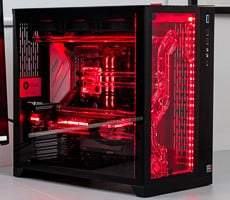Alienware M18x R2 Gaming Laptop: Dual GPUs Attack
|
|
|

It hardly seems fair to toss the M18x R2 into the ring with other gaming laptops we've reviewed, but as lopsided as the results may be, it underscores how far over the top Alienware built this thing. It also highlights the advance of technology. The updated R2 model in our possession nearly tripled the PCMark Vantage score compared to an older model Alienware M18x built around Sandy Bridge and wielding a pair of Radeon GPUs. Part of that strength comes from the system's pair of Samsung SSDs, which push IO throughput in this particularly disk-sensitive benchmark.

Equally obscene in the laptop space is the PCMark 7 score our M18x system returned. We've seen higher scores before, but only from enthusiast-grade desktop rigs, never from a laptop. Notice the balanced performance in the categorical breakdown PCMark 7 provides, which indicates the M18x R2 is equally suited for any task you throw at it, be it gaming or productivity chores.
|
|
|
The latest version of Futuremark's synthetic 3D gaming benchmark, 3DMark11, is specifically bound to Windows 7-based systems because it uses the advanced visual technologies that are only available with DirectX 11. 3DMark11 isn't simply a port of 3DMark Vantage to DirectX 11, though. With this latest version of the benchmark, Futuremark has incorporated four new graphics tests, a physics tests, and a new combined test. We tested the graphics cards here with 3DMark11's Performance preset option.

Wielding a pair of NVIDIA GeForce GTX 680M GPUs in SLI, the M18x cut through 3DMark 11 like one of Dexter's blades through slicing through a helpless body. The GTX 680M is the fastest GPU on the planet, and the M18x benefits from having two them push pixels around like a schoolyard bully. The system also benefits from a quad-core Ivy Bridge processor and dual SSDs in a RAID 0 configuration, but by and large, 3DMark 11 is highly influenced by the graphics subsystem.







